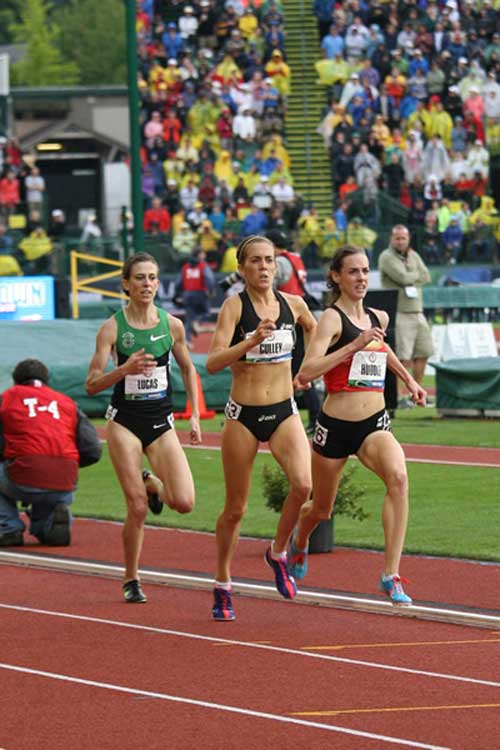The women’s 5,000 meters and the men’s discus were moving for different reasons. The close finish of the 5,000m, with Julia Culley winning over Molly Huddle and Kim Conley catching Julia Lucas at the finish, was, well, epic. And the discus throw by Lance Brooks, where he hit 65.15m, with the A standard being 65 meters, after inching, or centimetering, closer and closer for three throws!
Elliott Denman decided to write about both events, and we are glad that he did…..
 Huddle followed by Culley and Lucas, 2012 U.S. Olympic Trials, 5,000 meters
Huddle followed by Culley and Lucas, 2012 U.S. Olympic Trials, 5,000 meters
By Elliott Denman
EUGENE, Oregon
June 28, 2012
Sure, the USA Olympic Trials are all about warm and fuzzy scenes, of 1-2-3 finishers celebrating their achievements, grabbing their little American flags, and jogging their victory laps whilesporting smiles that sometimes seem to stretch from Oregon to England.
Understand, however, that just a handful of these finals are decided by major margins.
A whole bunch are determined by infinitesimal differentials.
And that’s what make the Trials the quadrennial drama they always are – sky-high winners, simultaneously deep-down-in-the-dumps near-missers.
Of course, this whole business of “A” and “B” qualifying marks -who has ’em coming in, who hasn’t ’em heading out – has put a whole new spin onseveral events at these ’12 Trials.
But it is what it is and don’t count on any phase of the scenario changing anytime soon.
We had two such beauties at Hayward Field on Thursday.
One involved very large men. The other involved ladies seemingly a third their size.
Trials drama has always come in assorted packages.
First, over at the discus ring…
Through five rounds, the USA men’s disc-whirling team seemed to be Lance Brooks, Jason Young and Ian Waltz.
Millikin U. alum Brooks had whipped one out 211-5 in round three; Texas Techer Young had a 203-7 in round five; Washington Stater Waltz a 201-2 in round three.
Real thunder was on the round-six horizon.
Brooks stretched his lead, grabbed his vital “A” and clinched his ticket with a 213-9.
Young improved marginally to 203-11.
But with Waltz fouling out of round six, Boise Stateman Jarred Rome muscled one out 207-10 to snatch second.
Great for him was definite dismay for Waltz, who’d been throwing on a national level since 1997, who’ d placed second in the ’04 Trials and won it all here in ’08.
Said Rome: “I went for it on my last throw and gave it 100%. I thought if I slip, I slip.
“Fortunately I didn’t.”
Waltz wasn’t ready to share his rival’s good fortune.
“Discus throwing is something you get better at with age,” said Young, who made his first national team at age 30. “You really have to have along-term focus.”
And if things get blurry, you always need a drawing board to return to.
Meanwhile, back on the track, the women’s 5000 meters was providingequally grand theater.
For much of the way, at least five leading candidates were making statements, jostling for the lead,shuffling positions up and down, taking each other’s measure, seeing who’d have it at the end and who wouldn’t.
At last, Rutgers grad Julie Culley made the loudest statement of all, spurting home in 15:13.77, with Notre Damer Molly Huddle on her heels in 15:14.40.
Would you believe that the next three placers would cross the line all of 00.19 seconds apart? And all as proud owners of their golden “A” passports.
Well, believe.
The formerly front-running North Carolina Stater Julia Lucas, seemingly running on empty, got herself over the line in 15:19.83.
Or all of four hundredths of a second too late. Cal-Davis grad Kim Conley’s 15:19.79 was that tad of a tad quicker.
Meanwhile Dartmouth’s NCAA champion Abbey D’Agostino, had it all just a fingertip’s length away, too. All her 15:19.98 got her was fifth place.
It’s the debate over the dead-heated battle for third in the women’s 100 that’s been in the headlines all week. Who’d ever believe that a 25-lap race could give that one a run for its money?
“The last 100 meters, “that was a kinda a scary moment,”conceded Culley.
“In 2008, it was just my goal to get here (to the Trials; she did and ran seventh.)
“The hardest challenge the day-of is your head, and not talking yourself out of it.”
“This is beyond a dream come true,” said Conley. ” Four years ago, I was watching the Olympic Trials on TV thinking ‘Wow, it would be cool to run here,’and four years later I’m an Olympian. I still can’t believe it.”
At the very same time, it was beyond a nightmare to Lucas and D’Agostino.
Crying towels came in handy in the mixed zone.
Bottom lines: “Getting there” is obviously wonderful. Staying home is obviously a detriment to long-term mental health.
What further joy/trauma await Trialspeople Friday, Saturday and Sunday?



















